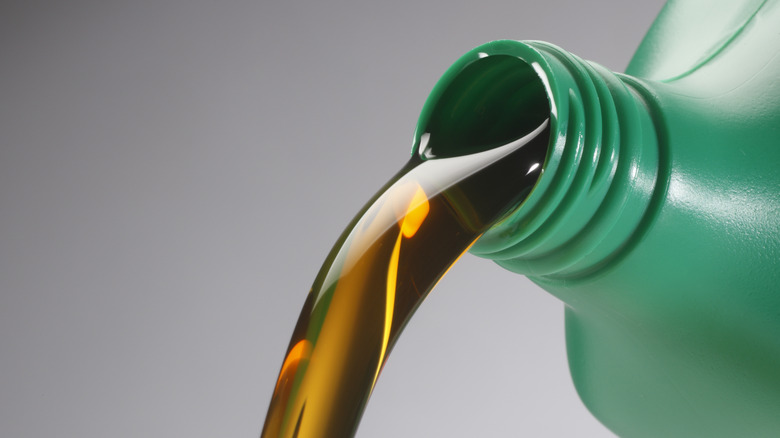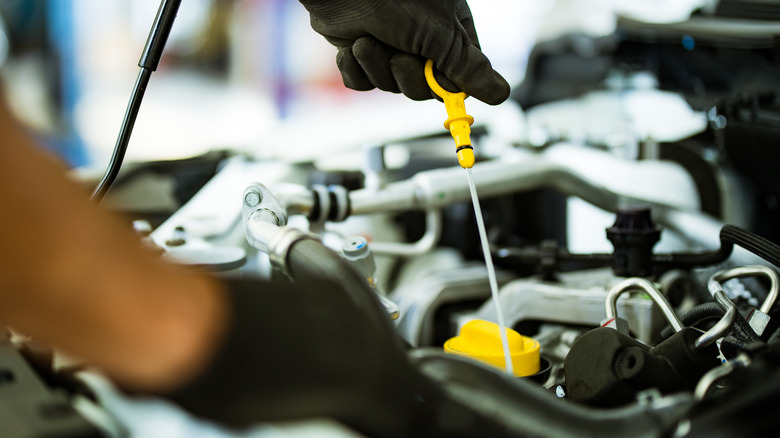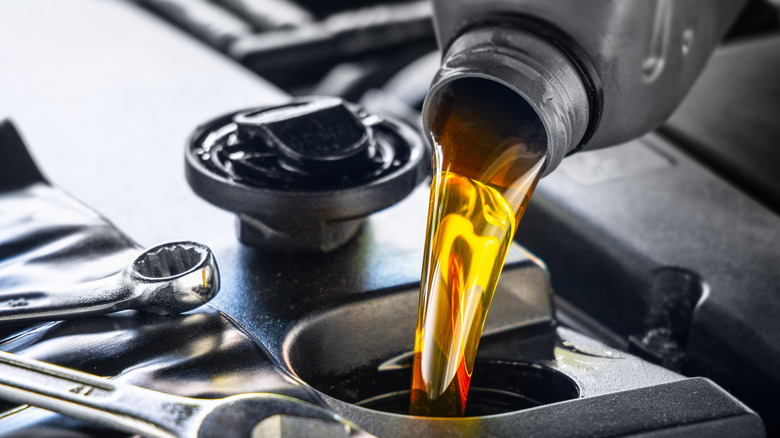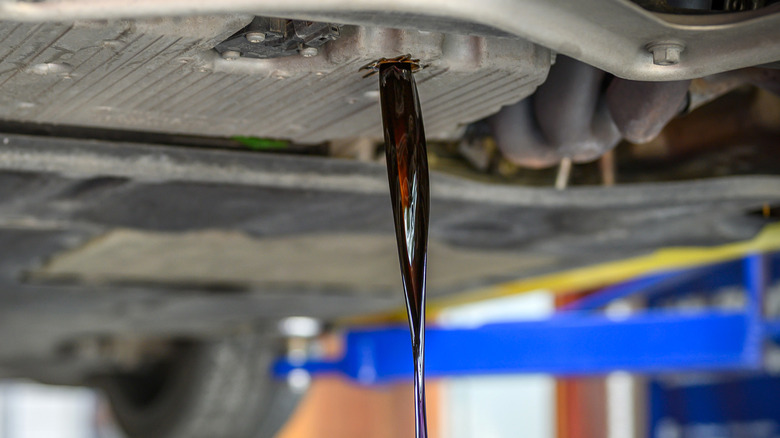What The Color Of Your Engine Oil Is Trying To Tell You
Engine oil performs several vital functions: it keeps everything lubricated and running smoothly while also preventing corrosion inside the engine block, keeps things somewhat clean, and even helps cool the engine a little. Due to its workload, engine oil has a limited lifespan and must be changed regularly. Changing your oil on schedule helps remove contaminants that have built up within the liquid from the engine and ensures the oil within the block is performing all of its vital functions to the best of its ability.
While oil changes tend to happen at set intervals, and an engine warning light is dedicated to alerting you if something oil-related has gone drastically wrong, your engine oil still needs a little attention. Ideally, motor oil should be manually checked at least once per month to ensure the vehicle has the correct amount and no obvious problems are present. Your oil should be checked before any long trips, too, as the cause of a future breakdown may manifest within the viscous fluid.
Checking your oil is simple
Regularly checking your oil is one of the easiest vehicle maintenance tasks. It can prevent serious and expensive engine issues and is especially important on older cars, as wear on the engine will lead to small amounts of oil being burned off during combustion. This can lead to your oil level dropping below the minimum amount, which can cause serious damage to your engine. Checking your oil at a gas station is also a good idea, as most gas stations stock various types of motor oil. If your oil levels are a little low, you can just pop inside, buy a quart of the oil you need, and top your vehicle up.
To check your oil, you need to:
- Turn off your engine.
- Pop your vehicle's hood.
- Grab a rag or some paper towels.
- Locate the dipstick, then pull it out. The dipstick's exact location varies depending on your engine, but it is usually identifiable by its easy-to-spot yellow or orange handle.
- Wipe the stick clean and note the two lines near its tip.
- Slowly reinsert the dipstick before pulling it back out.
If the oil level is between the two lines, you're good. If it is on the bottom line, adding a quart may be a good idea, and if the oil level is lower than the bottom line, your car needs oil ASAP. The oil's appearance may also indicate things about its condition and the overall condition of your vehicle.
Fresh engine oil is amber colored
If your engine oil is new, it should be similar in color to light honey or amber and have a consistency like olive oil. Unfortunately, it doesn't retain this color for long and will darken slightly fairly soon after your oil change. The oil darkens for a few reasons, with contaminants being a reason it could dim a shade or two very quickly. Dust, dirt, soot, and bits of ground-up metal all inhabit your engine block, and they will quickly end up mixed into your new oil.
"Heat cycles" also play a part in your oil's color. An internal combustion engine does not run cold; your motor will generally run at around 220 degrees Fahrenheit when it reaches operating temperature. Each heat cycle darkens the oil further, so before long, that light honey-colored liquid may be closer to maple syrup. This is nothing to worry about and is a normal part of the oil's life cycle. The darkening itself won't affect the engine oil's performance.
Milky or foamy oil is rarely a good sign
If you check your oil and it has suddenly become milky white, foamy, sludgy, or light brown, then something may have gone majorly wrong. If there is an issue, you'll probably notice milky oil, which tends to be thicker than regular engine oil, on the underside of your oil cap. Good engine oil develops into this milky mess when it is exposed to moisture, so on a basic level there is an indication that water or some other undesirable liquid has made its way into your oil system.
At worst, this could indicate a blown head gasket. The head gasket keeps your coolant system out of the engine's cylinders. When it fails, coolant will make its way in and ultimately mix with your oil. Other causes include sludge, which forms in the crankcase when an engine stays idle for a long period and mixes with the oil, and operating a vehicle in a very humid climate. Driving through deep water can also cause this issue. If you have good reason to believe water has made it into your engine, don't drive your vehicle.
Whatever the cause, milky oil isn't going to do its job properly. If you leave it in there, it can impact performance, cause corrosion, and damage parts. You should consult a mechanic ASAP, determine the exact cause, and have it fixed. Once the cause is determined, the engine will need to be drained and flushed out before new oil is added.
Black oil isn't always an issue
When most people picture motor oil, they think of an opaque black liquid. This is what usually pours from an engine's oil pan at the start of an oil change, so it's understandable why people think black oil means it's time to head to Jiffy Lube. However, black oil isn't a definite sign that your engine oil is past its best. Even if you don't drive too often, additives within the oil naturally darken over time so relatively fresh oil can still go black.
The best way to determine when your next oil change is due is to consult your car's manual. It will give a clear indication of when you should swap out this vital lubricant. Oil changes are usually performed based on milage or after a set period of time. It's usually a case of what comes first, so a newer car may be fine with an annual oil change or one every 10,000 miles if it hits that milestone before the year is up. Older vehicles may need more regular oil changes. Other factors also play into your engine oil's condition.
If you live in an area with a particularly hot or cold climate, or if you frequently take short trips where your engine won't get up to temperature, or if you drive down particularly dusty roads regularly, your oil will need changing more often. Just make sure you don't skip one altogether, as that could have serious long-term consequences for your vehicle.



